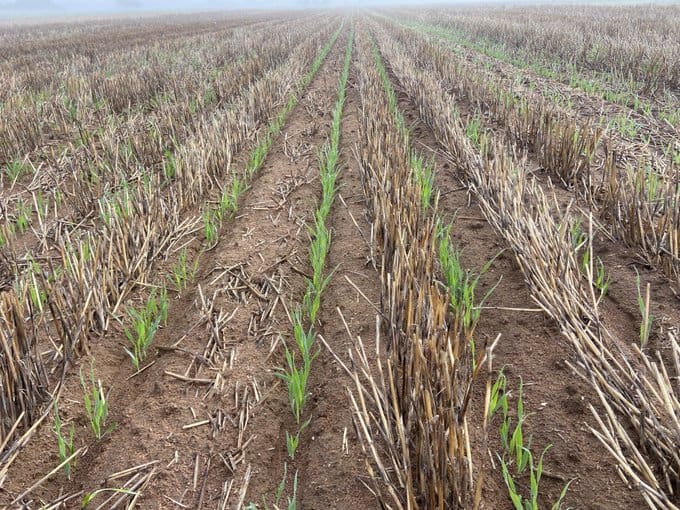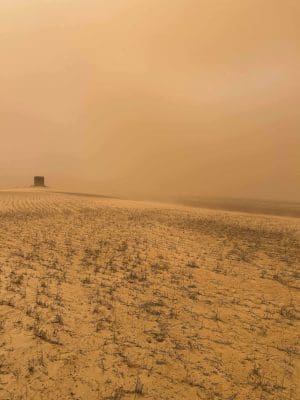
This paddock of Neo CL barley near Moree last week shows good establishment after regular rain. Photo: Matt Naumann, InterGrain
PRICES paid for wheat and barley have dropped by up to $10 per tonne in the past week on softer offshore markets, and patchy rain for the areas that need it in south-eastern Australia.
Pockets of southern and central New South Wales got the best of the rain, while Victoria’s and South Australia’s main cropping regions generally got 10mm or less, although some recorded more than 25mm.
Traders report the softening global wheat market, a slowing in Australian wheat and barley exports, and the factoring in of a big wheat carry-out in north-west NSW in particular have prompted some NSW growers to sell a load or two of grain.
Traded volumes are said to be thin, with growers in NSW and Queensland busy planting in their main window, and Vic and SA growers generally feeling uncertain about production prospects from their mostly dry-sown crops.
| Prompt May 22 | Prompt today | New-crop May 22 | New-crop today | |
| Barley Downs | $340 | $337 | $345 Jan | $335 |
| ASW Downs | $350 | $342 | $356 Jan | $345 |
| Sorghum Downs | $355 | $350 | NQ | NQ |
| Barley Mel | $375 | $373 | NQ | NQ |
| ASW Mel | $385 | $378 | NQ | NQ |
Table 1: Indicative prices in Australian dollars per tonne.
Northern season consolidates
Growers in Qld and northern NSW are flat out planting wheat, and getting ready to move into chickpeas next month.
Apart from Central Qld, where harvest is still going, most growers have sold their sorghum, and bulk export programs are winding down.
Market talk is that the Walgett and Coonamble districts alone will have at least 2 million tonnes of wheat to carry over into new crop, and with bunkers and silos still full to the east and north, consumers are comfortable with stock levels.
“Everyone seems to say they’re covered and just needs a little bit to top up,” one trader said.
“Growers are busy planting, and sitting back when it comes to selling and hoping for higher prices come July 1.
Qld’s grain-growing areas had very little rain in the week to 9am today, but northern NSW had some handy falls to wet topsoil and further consolidate prospects for above-average yields.
Higher northern NSW registrations included: Coonamble and Nyngan 10mm; Dubbo 35mm; Gunnedah 28mm; Narrabri 18mm; Peak Hill 23mm; Quirindi 40mm, and Trangie 31mm.
Break arrives for some in south
As export demand for wheat and barley wanes, the southern grain market has eased, despite some buying of barley for drought feed for those with sheep and cattle.
“We’ve got a few markets going on at the same time,” Pinion Advisory broker Brad Knight said.
“There’s the drought market, and then there’s your consumers, and export.”
It means bids and offers are up to $15/t apart.
The quoted Melbourne market has eased to reflect grain coming in from southern NSW’s Riverina district, where some districts got enough rain to see them through winter.
Volume traded in the south remains thin, as the majority of growers focus on getting the last of their crop in, and others have held back from starting their plant before this rain.
Prior to the rain, country south of Parkes was generally in need of a follow-up rain to help germinated or germinating crops along.
West of Grenfell, farmer Broden Holland said he received 40mm over the past week.
“We’ve finished sowing, which is probably around 10 days later than normal,” Mr Holland said.
“Our canola is 80pc germinated, and was before the rain, wheat is 70pc or so up, and with faba beans, one paddock is up, and the other one is coming up.”
Crops south and west of Grenfell are generally not as advanced with sowing or germination, but rain in the week today has boosted prospects for the many paddocks that got a timely soak.

Fierce winds and some rain came to parts of drought-stricken SA and western Vic last week. Photo: Ewan Porker, Karoonda, SA
In the southern half of NSW, higher falls in the week to today include: Ardlethan 33mm; Cootamundra 38mm; Deniliquin 22mm; Temora 44mm; West Wyalong 38mm, and Young 63mm.
Dairy farmers, and those with sheep and beef cattle, are buying loads of barley here and there as a backstop for winter feed, because pasture growth after this recent rain will be limited with winter around the corner.
Conditions remain desperately dry in much of SA and western Vic, and roughage at varying price points is making its way south.
As well as the preferred cereal hay, graziers and mixed farmers are chasing corn and rice straw and almond hulls from the Riverina, and pasture hay from as far afield as western Qld.
Grain Central: Get our free news straight to your inbox – Click here

HAVE YOUR SAY